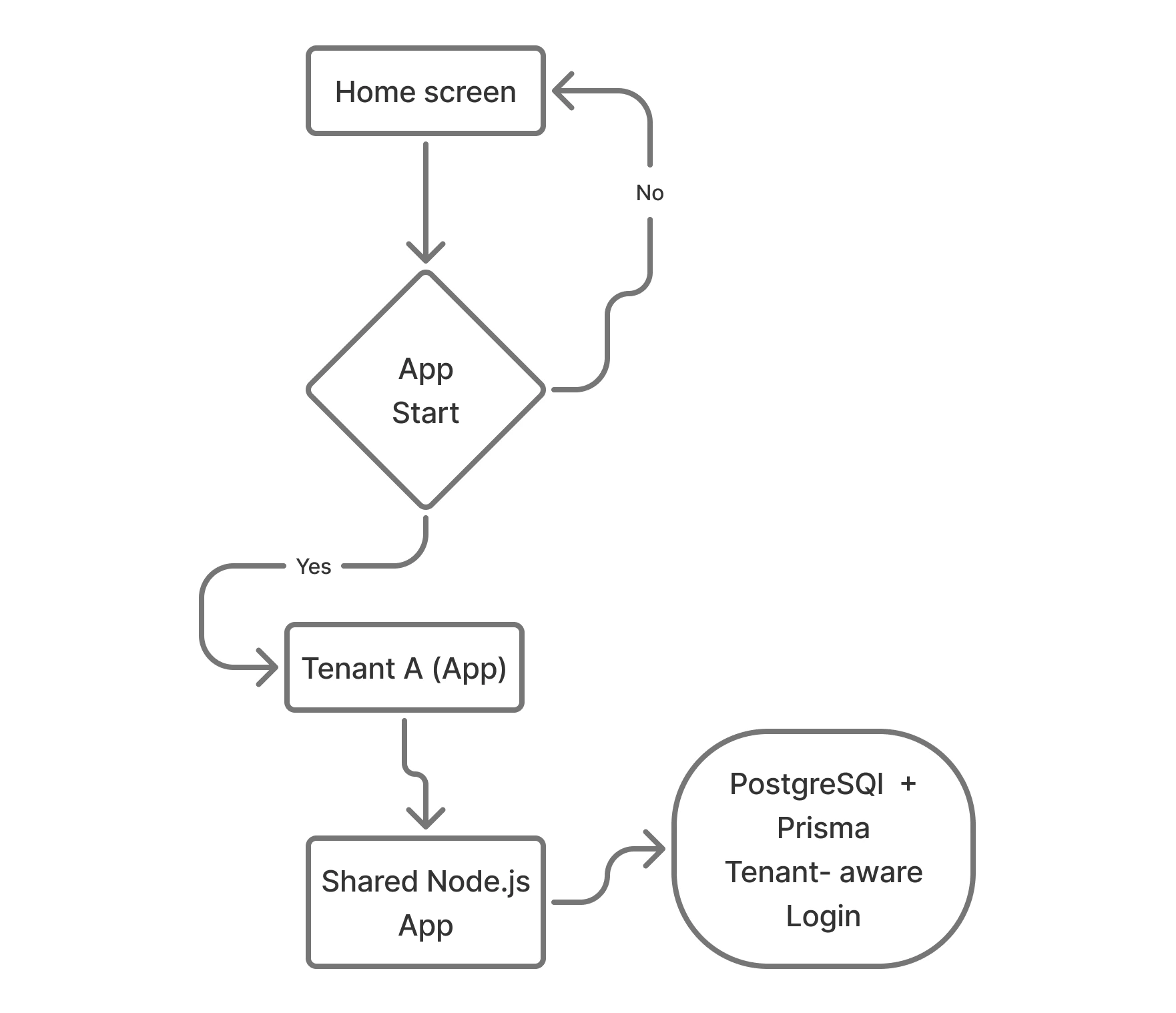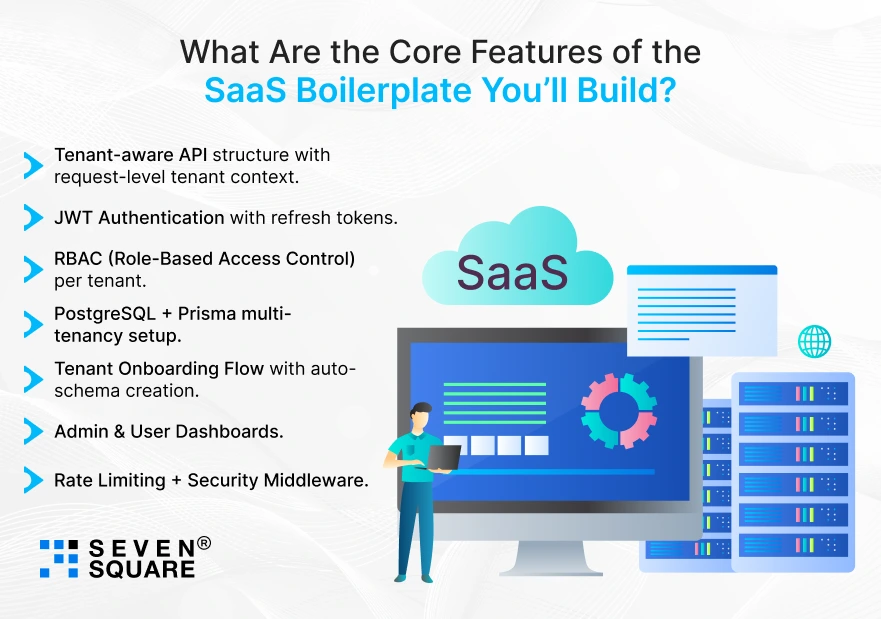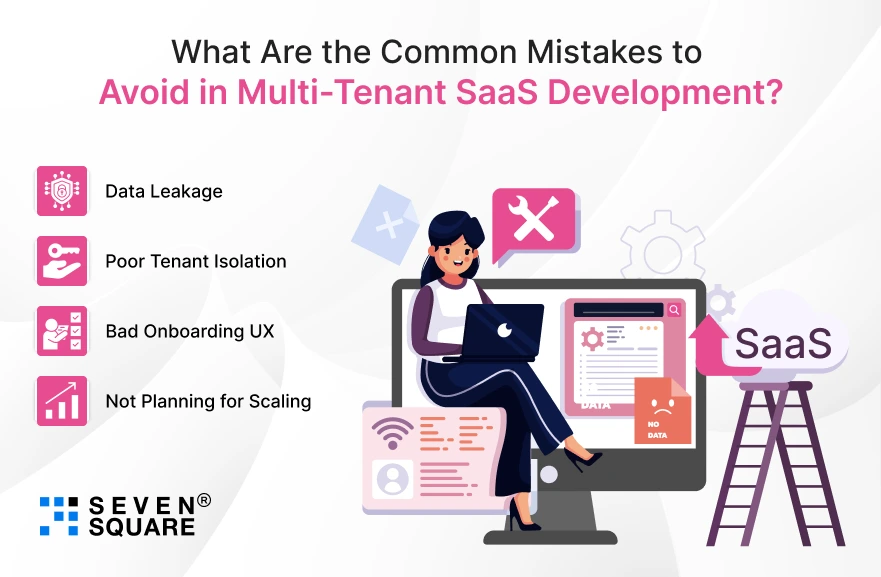Most startups waste weeks or even months building the same user login systems, tenant management, and basic API structure every time they launch a new SaaS app.
But in 2025, speed to market is everything.
That’s where a solid SaaS boilerplate can be helpful, especially when you’re dealing with multi-tenant SaaS applications built using Node.js.
With the growing demand for SaaS platforms that serve multiple clients (a.k.a. tenants) under one codebase, building a multi-tenant SaaS boilerplate in Node.js has become more important than ever.
In this blog, you’ll learn how to build a fully functional, scalable SaaS boilerplate from scratch using Node.js, complete with:
- Tenant-aware API architecture
- Authentication (JWT)
- Role-based access control
- Prisma + PostgreSQL for multi-tenancy
- GitHub repo with full source code
What Is a Multi-Tenant SaaS Architecture?
At its core, a multi-tenant architecture allows a single app instance to serve multiple clients (tenants) while keeping their data securely isolated.
Think of platforms like Shopify or Notion, each user or organization has their own private space, but they’re all powered by the same backend infrastructure.
Types of Multi-Tenant SaaS Architectures:
- Shared Database, Shared Schema: Fastest to set up, but hardest to isolate.
- Shared Database, Schema-Per-Tenant: Offers a nice balance between performance and tenant separation.
- Database-Per-Tenant: Best for enterprise-grade isolation but adds infrastructure overhead.
Here’s a simple diagram to help visualize how multi-tenant architecture in Node.js works:

Each tenant request is handled dynamically to ensure tenant isolation, even within shared infrastructure.
Why Choose Node.js for a Multi-Tenant SaaS Boilerplate?
Node.js has become the go-to backend for building fast, lightweight, and scalable SaaS products.
Here’s why it’s a perfect fit for your multi-tenant SaaS boilerplate:
- Speed & Performance: Built on Chrome’s V8 engine, Node.js handles concurrent requests efficiently, which is perfect for SaaS use cases.
- Flexibility for APIs & Microservices: Node.js makes it easy to build REST APIs, event-driven systems, or microservice-based SaaS platforms.
- Huge Ecosystem: Whether you need auth, RBAC, database connectors, or deployment tools, Node.js has it all.
Node.js vs Python/PHP
| Feature | Node.js | Python | PHP |
|---|---|---|---|
| Performance | High | Medium | Slower |
| Ecosystem | Massive | Mature | Niche |
| Multi-Tenant Friendly | Yes | Yes | Complex |
For scalable SaaS apps, Node.js + PostgreSQL + Prisma is a stack that delivers on performance and maintainability.
What Are the Core Features of the SaaS Boilerplate You’ll Build?

This is a production-ready SaaS starter template you can clone, deploy, and scale. Here’s what’s inside:
- Tenant-aware API structure with request-level tenant context.
- JWT Authentication with refresh tokens.
- RBAC (Role-Based Access Control) per tenant.
- PostgreSQL + Prisma multi-tenancy setup.
- Tenant Onboarding Flow with auto-schema creation.
- Admin & User Dashboards.
- Rate Limiting + Security Middleware.
You can also extend this boilerplate to add:
- Billing (Stripe).
- Email/SMS notifications.
- Feature flags per tenant.
What Are the Tech Stack & Tools You’ll Use?
Here’s the tech stack used to build this multi-tenant SaaS boilerplate in Node.js:
| Tool | Purpose |
|---|---|
| Node.js + Express | Core backend framework. |
| PostgreSQL | Relational DB with multi-tenant schema support. |
| Prisma ORM | Type-safe DB access and tenant-aware queries. |
| JWT / Auth | Secure token-based login system. |
| Redis (Optional) | Rate limiting and session management. |
| GitHub Actions | CI/CD automation. |
| Railway / Vercel | Hosting & quick deployment. |
What Are the Common Mistakes to Avoid in Multi-Tenant SaaS Development?

Multi-tenancy comes with great power and responsibility. Watch out for these common mistakes:
- Data Leakage: Accidentally mixing tenant data is the biggest risk. Always validate tenant context on every request.
- Poor Tenant Isolation: Use schema-based or DB-based separation to prevent cross-tenant access.
- Bad Onboarding UX: If users struggle to sign up or invite teammates, they’ll leave. Simplify tenant + user flows.
- Not Planning for Scaling: Start with scaling in mind; modular APIs, pagination, background jobs, and rate limiting are crucial.
How to Set Up a Boilerplate from Scratch?
Let’s start building your Node.js SaaS starter template from scratch. Here you can learn about project scaffolding and folder structure optimized for multi-tenancy.
Step-by-Step Setup
1. Initialize the Project:
mkdir multi-tenant-saas
cd multi-tenant-saas
npm init -y
npm install express prisma @prisma/client jsonwebtoken bcrypt dotenv cors
npx prisma init
2. Project Folder Structure:
multi-tenant-saas/
├── src/
│ ├── controllers/
│ ├── middleware/
│ ├── routes/
│ ├── services/
│ ├── utils/
│ └── app.js
├── prisma/
│ └── schema.prisma
├── .env
├── package.json
This layout separates concerns and supports scalability across multiple tenants.
How to Implement Multi-Tenancy Logic? (Shared Schema Example)
In a shared schema setup, each record is tagged with a tenantId. Middleware ensures requests are scoped to the correct tenant.
Middleware for Tenant Detection
// src/middleware/tenantResolver.js
module.exports = (req, res, next) => {
const tenantId = req.headers['x-tenant-id']; // Or extract from subdomain/token
if (!tenantId) return res.status(400).json({ error: 'Tenant ID missing' });
req.tenantId = tenantId;
next();
};
Dynamic Tenant Context in Prisma
// src/utils/prismaClient.js
const { PrismaClient } = require('@prisma/client');
const prisma = new PrismaClient();
module.exports = (tenantId) => {
return {
user: {
async findMany() {
return await prisma.user.findMany({ where: { tenantId } });
}
},
// Add other tenant-scoped models
};
};
User & Tenant Onboarding Flow (With Code)
When a new company signs up, we create:
- A new tenant record.
- A user account.
- Default roles and permissions.
Signup Flow Sample Code
// src/controllers/authController.js
const prisma = require('../utils/prismaClient');
exports.signup = async (req, res) => {
const { companyName, email, password } = req.body;
const tenantId = crypto.randomUUID();
const hashed = await bcrypt.hash(password, 10);
await prisma.tenant.create({
data: {
id: tenantId,
name: companyName,
users: {
create: {
email,
password: hashed,
role: 'admin'
}
}
}
});
res.json({ message: 'Tenant created', tenantId });
};
This ensures each signup is a new isolated tenant.
How to Add Role-Based Access Control? (RBAC)
Each tenant may have different roles: admin, editor, viewer, etc.
RBAC Middleware
// src/middleware/authorize.js
module.exports = (requiredRole) => {
return (req, res, next) => {
const userRole = req.user?.role;
if (!userRole || userRole !== requiredRole) {
return res.status(403).json({ error: 'Access denied' });
}
next();
};
};
Example Route Using RBAC
app.get('/admin-only', authorize('admin'), (req, res) => {
res.send('Welcome, admin!');
});
RBAC allows fine-grained control per tenant, improving security and UX.
Want a Complete NodeJs Solution? Contact Us Now!
How to Handle Deployment & Hosting for Multi-Tenant SaaS?
When deploying a multi-tenant SaaS boilerplate, security, scalability, and automation are key.
Deployment Tools:
- Railway: Quick PostgreSQL + Node.js deployment.
- Render: Auto-deploy from GitHub with background workers.
- Vercel: Best for frontend; use as a hybrid with backend hosted separately.
Best Practices:
- Always set these .env vars:
DATABASE_URL=...
JWT_SECRET=...
PORT=3000
- Use GitHub Actions for CI/CD:
# .github/workflows/deploy.yml
jobs:
deploy:
runs-on: ubuntu-latest
steps:
- uses: actions/checkout@v3
- name: Install & Build
run: npm install && npm run build
Here’s the Complete GitHub Code to Create a Multi-Tenant SaaS Boilerplate in Node.js.
Build Once, Scale Infinitely
You’ve just learned how to create a scalable multi-tenant SaaS boilerplate in Node.js from scratch.
Whether you’re launching your next big product or helping clients build theirs, this boilerplate can cut down your dev time dramatically.
- Use it as a starter template.
- Fork it and add features.
- Deploy and test in real-world environments.
FAQs
- A reusable codebase that supports multiple tenants (customers) with shared infrastructure but isolated data and access.
- Technically yes, but PostgreSQL offers better support for schema-per-tenant setups, which improves isolation and security.
- Use schema-per-tenant or DB-per-tenant for isolation, async workers for background jobs, horizontal scaling for API services, and Redis for session and rate management.
- Yes, Prisma supports multi-tenancy through dynamic schema or database switching. It works great with PostgreSQL in this setup.